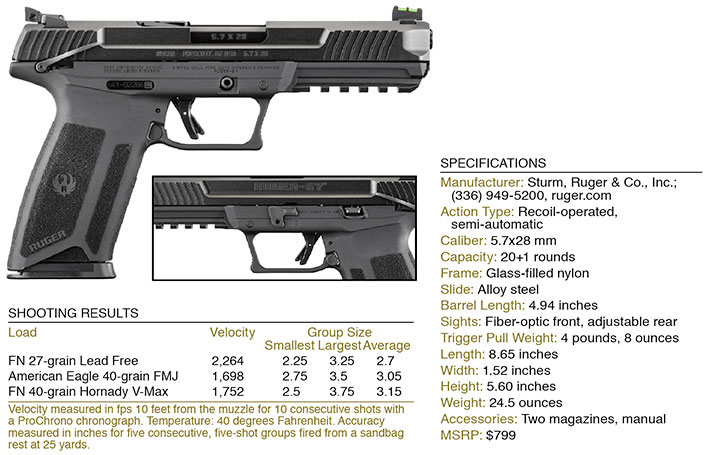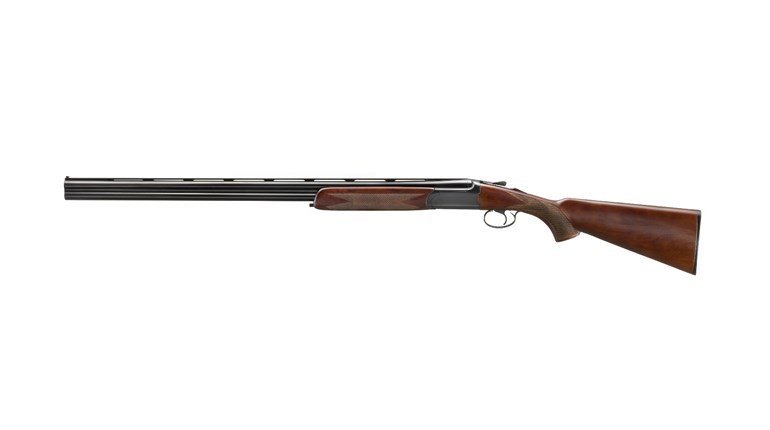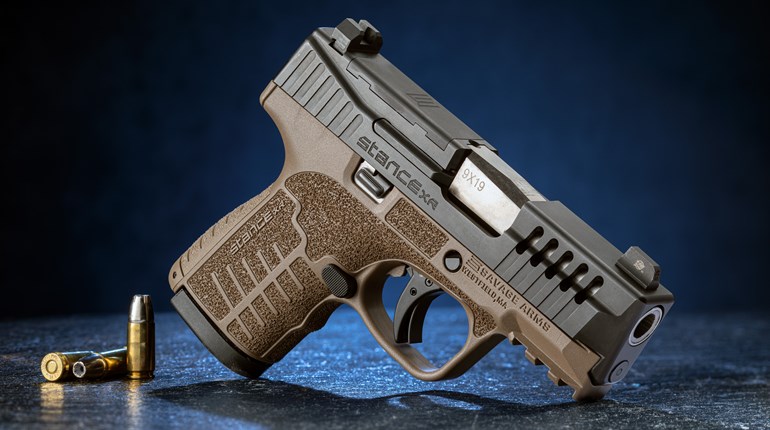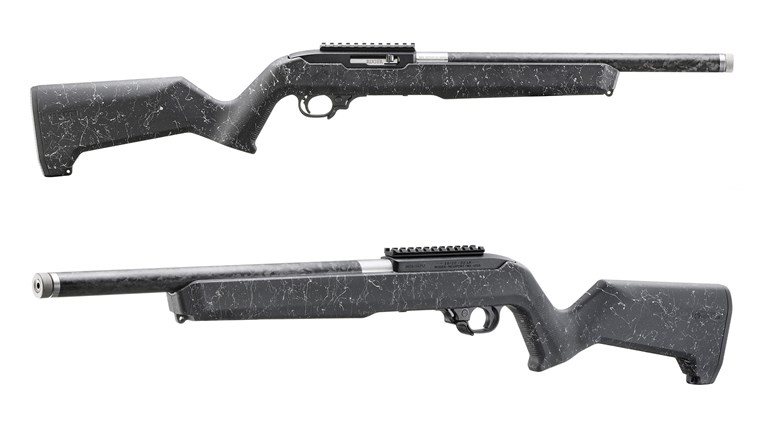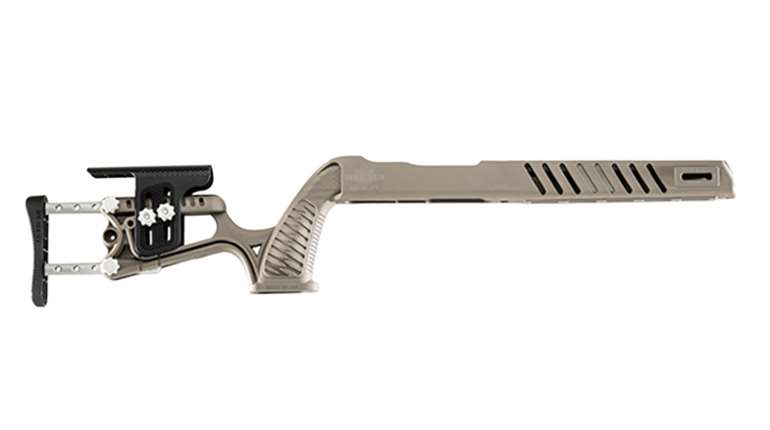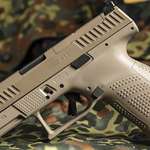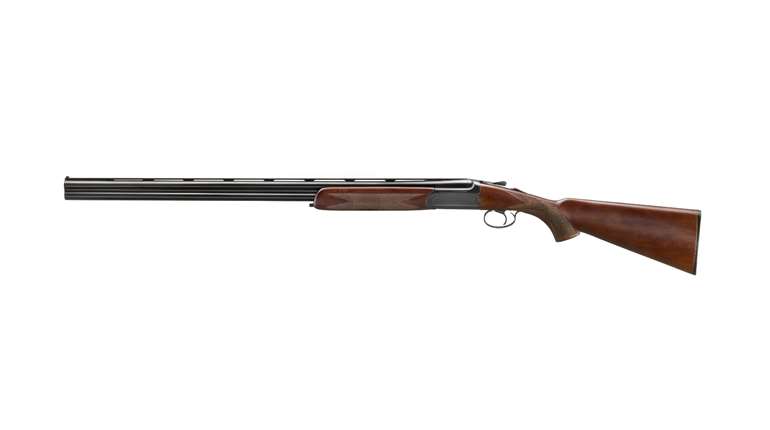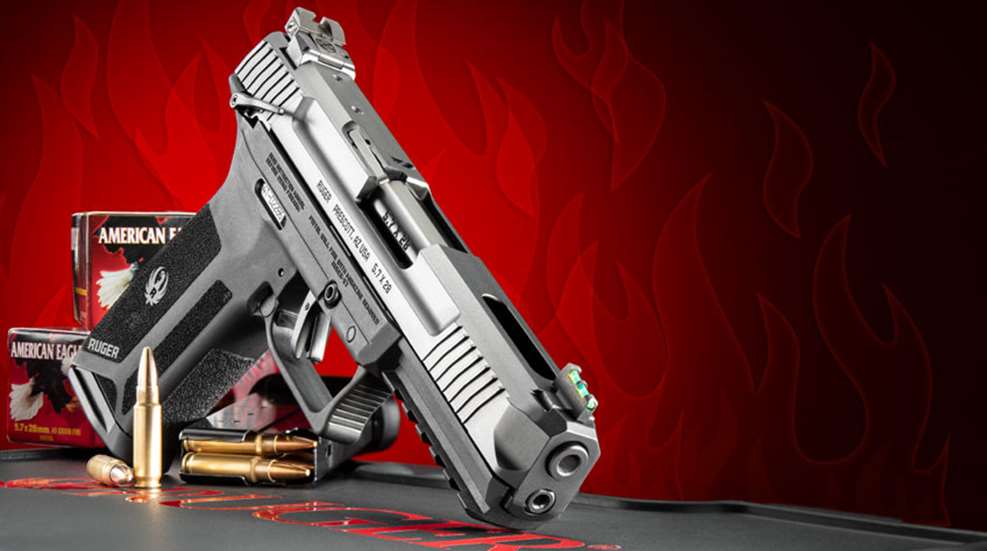
Is Ruger disrupting the firearm industry again? The company’s core belief that new products are necessary for growth has it constantly going through a process of designing, testing and marketing new products. Some of these have shaken up the market and driven growth throughout the industry.
The company’s Gunsite Scout Rifle is one example, but perhaps the best of them all is the LCP, a pocket-size .380 ACP pistol suitable for concealed carry. A huge success for Ruger, this little pistol drove development in defensive .380 ammunition, accessories and a whole slew of new concealed-carry pistols.
So here we have the Ruger-57 pistol—a full-size pistol suitable for personal defense and plinking—chambered for a somewhat obscure cartridge most American shooters have likely never fired. Why in the world would a firearms manufacturer roll the dice on something with essentially no demand?
It’s exactly the kind of thing the folks at Ruger revel in as its new products create their own demand and drive product and ammunition development throughout the firearm industry.
The 5.7x28 mm cartridge was developed in the mid-’80s by Fabrique Nationale (FN) for its P90 submachine gun, introduced in, well, 1990. While the P90 and Five-Seven pistol are in use by some 40 police and military agencies throughout the world, the cartridge remains something of a rarity here in the United States.
The Ruger-57 is a full-size, lightweight pistol weighing only 24.5 ounces empty and about 28 ounces fully loaded. The frame is a textured, glass-filled nylon containing the anodized aluminum fire-control chassis, which is the actual “firearm” and serialized part.
The grip is narrow, but hand-filling and that, and the grip angle, allow the pistol to point naturally in my hands. The molded-in texturing is grippy without being sharp, allowing for plenty of purchase to handle the massive recoil generated by this tiny cartridge. (OK, just kidding, I wanted to see if you’re paying attention. We’ll get back to the recoil in a bit.)
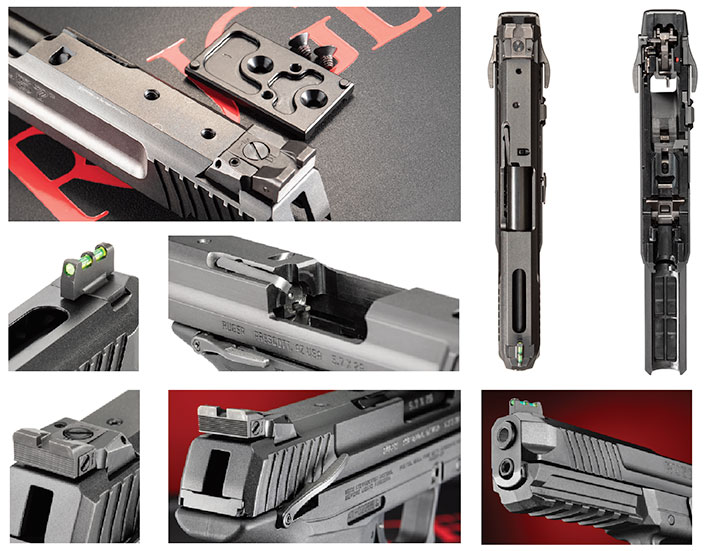
The pencil-thin barrel is 4.9 inches long, the overall length of the pistol is 8.6 inches, the height is 5.6 inches with a frame width of only 1.2 inches. The barrel has eight grooves with a 1:9 right-hand twist. The pistol is going through the process of being approved for sale in Massachusetts and, unfortunately, is not going to be sold in California in my lifetime.
The large, easily operated magazine release is reversible following the instructions in the well-written manual. Frame-mounted controls include nicely contoured ambi thumb safeties without sharp edges, proving someone at Ruger gets it and understands weird angles and sharp thumb safeties are a plague that needs wiping out.
The slide lock resides on the port side, just forward of the thumb safety and ahead of that is the takedown lever. The dustcover has a long, five-slot Picatinny-style accessory rail that should accommodate most lights, lasers and the like.
The trigger is decidedly Glock-like or, as the Ruger folks would prefer to state it, similar to the LCP II trigger, with the flippy lever thingy that prevents the trigger moving to the rear unless the finger is resting on the trigger. Ruger calls the trigger a Secure Action Trigger with positive reset and I can’t argue with that. The trigger of my sample breaks at 4.5 pounds according to my Lyman electronic trigger tester. There’s a bit of slack or take-up, whereupon the trigger snaps crisply and resets positively.
Jeff Cooper instructed us you need a trigger you can manage and sights you can see, so what about the sights on the 57? Actually, they are very, very good. The rear is fully adjustable for windage and elevation and the front is a green fiber optic that combine to provide a really good sight picture to my tired eyes.
As is usual for Ruger, the rear sight-adjustment screws require thin-bladed screwdrivers of two sizes, the windage-screw head being considerably smaller than the elevation screw. This has been driving me a bit batty for ages and I really wish they would come up with sights that require only one screwdriver for adjustment.
But I can report a certain amount of positive progress with the 57, as the windage screw finally turns in the direction you want to move the sight, as opposed to the opposite direction for all former Ruger sights with which I’m familiar. Turn the screw to the right and the sight moves right, left for left. Turn the screw and move the sight in the direction you want to move the impact of the bullet on your target. Wonderful.
Since we’re talking about the sights, I suppose I should describe the rest of the slide. The ejection port is large and there are a series of angled cocking serrations fore and aft. The alloy-steel slide is finished in a black oxide and the barrel, visible through a port atop the slide, is finished in black nitride.
There is a port in the rear of the barrel and, if the lighting is right, you can peer into it and observe whether the chamber is loaded. The extractor, located near the top of the ejection port, doesn’t seem to stick up as a loaded-chamber indicator.
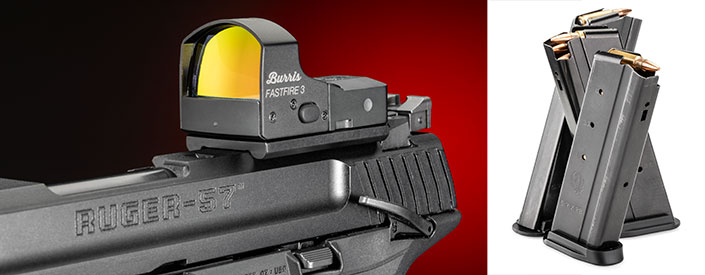
As are many pistols today, the Ruger-57 is optics ready. Forward of the rear sight there’s a flat milled into the slide with two tiny setscrews Loctited into two little holes. Removing these requires a tiny Allen wrench and some effort. In my case, one screw came out easily, the other caused my Allen wrench to twist like a pretzel.
Ruger has several mounting plates available for the mounting of red-dot sights and these are screwed down using the two recently vacated holes. My test pistol came with one mounting plate, but I understand consumer pistols don’t ship with one, so you’ll have to order the one you need from Ruger.
Field stripping is easily accomplished by following the directions in the instruction manual. That’s the usual gunwriter verbiage, but it isn’t quite what I experienced with the 57. Following the direction to ensure the pistol is unloaded, the slide is first locked to the rear.
Opposite the takedown lever is a pin that takes a bit of effort to depress. Ruger recommends using the base pad of one of the magazines; I ended up using a punch. Once the takedown lever is protruding from the frame, it can be rotated down. Next, rather than the conventional method of running the slide forward off the frame (I warned you to read the directions) the slide is moved forward about a quarter inch, then lifted straight up.
The recoil spring and barrel can then be removed from the slide in the usual manner. Ruger has designed this pistol to be taken apart without the need to press the trigger, a feature I heartily applaud.
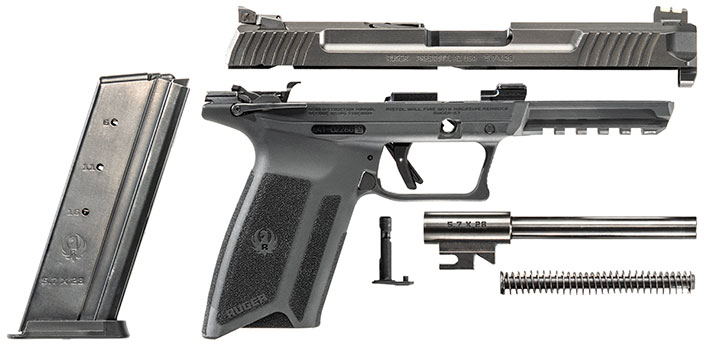
Reassembly is quite easy if one follows the instructions, but entirely impossible if, somehow while messing around with it, the takedown lever is allowed to snap back into the frame. (Ask me how I know.) Anyway, it really is quite easy, but I enjoin you, make sure the takedown lever is still out (or in the disassembly position) should you wish to avoid a couple of frustrating hours mucking about.
The two steel magazines provided with the pistol hold 20 rounds of small, zippy ammunition and herein lies the allure. Think of the 5.7x28 mm as a really, really high-velocity .22 Mag. of sorts. With 20 rounds onboard you have an impressive amount of firepower that has proven to be as effective, or more, than 9 mm ammunition, all in a lightweight package.
Loading the magazines is more AR-15-like than standard pistol magazines. Simply place the round on top of the follower and press straight down and slightly back. You can do it with relative ease, but I see Ruger has a magazine-loading tool available and I wish I had one during my extended range sessions with the pistol. The magazines, by the way, take down for cleaning in the usual manner of removing the baseplate.
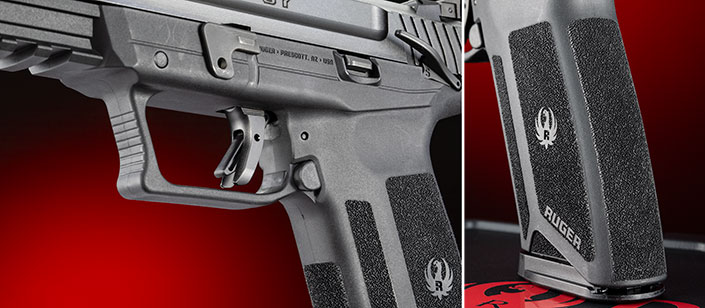
Speaking of accessories, Ruger has a full line of spare magazines, magazine-loading tools, holsters, mounting plates and optical sights available for the 57 and they can be found on the company’s website.
Since the Ruger factory in Prescott, AZ, is only a few miles from my home, I visited the factory to get a look at 57 production. The brightly lit, spotless factory is a modern wonder with cabinets of CNC machines lined up to create hallways. A single production line consists of two rows of machines and some workstations.
As the parts are machined, they move down the line and arrive at final assembly, go to test firing just steps away, then come back to the line for final cleaning and packaging. It’s all very efficient, with four to six CNC machines being managed by one worker who describes something of a circuit as he services one machine after another in what you might imagine as a production line ballet.
The factory folks kindly provided me with some factory test ammunition and a loaner Vortex red-dot sight, so it’s time to talk about shooting the pistol. Over a couple of range sessions consuming several hundred rounds, I found the pistol to be utterly reliable and as accurate as I can shoot it.
I was expecting considerable blast from the tiny, bottleneck cartridges, but found the muzzle blast and recoil to be about like shooting light loads in a 9 mm pistol. Perhaps because of a robust extractor or the high pressure of these little rounds, cases ejected up and quite a distance away.
I intended to use the Vortex Viper red-dot sight for accuracy testing, but ran out of elevation adjustment and was unable to get it zeroed. This forced me to do my group shooting with the Mark I eyeball, so if the accuracy of my shooting doesn’t seem up to your standards feel free to blame it on my old eyes. The pistol is more accurate than I am.
With the Ruger-57, the company has breathed new life into what originally was an intriguing cartridge, but one whose neglect kept it from enjoying the benefits of competition: lower prices, more options and easily available ammunition. That all changes now.
